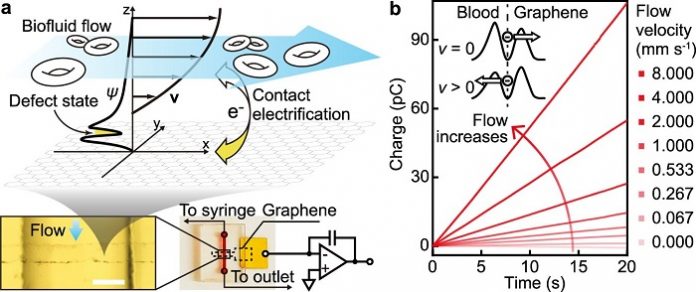Flow sensors, also known as flowmeters, are devices used to measure the speed of liquid or gas flows. The speed of biofluidic flow is a key physiological parameter but existing flow sensors are either bulky or lack precision and stability.
The new flow sensor developed by the UMass Amherst team is based on graphene, a single layer of carbon atoms arranged in a honeycomb lattice, to pull in charge from the continuous aqueous flow. This phenomenon provides an effective flow-sensing strategy that is self-powered and delivers key performance metrics higher than other electrical approaches by hundreds of times.
The graphene flow sensor can detect flow rate as low as a micrometer per second, that is, less than four millimeters per hour, and holds the potential to distinguish minimal changes in blood flow in capillary vessels. The performance of the graphene flow sensor has been stable for periods exceeding half a year.
The device his team created is the first one to be self-powered and high-performance, and it holds the potential to be implanted for long-term biofluidic flow monitoring. The most straightforward application, maybe in healthcare.
To implant, a micro flow monitor like the one his team developed in a small blood vessel is much simpler and safer than existing flowmeters, which are not suitable for low-flow measurement and need to be installed in a larger blood vessel.
Scientists and doctors may find it useful for their research and clinical applications, such as monitoring the blood flow velocity in deep-brain vessels to understand the functioning of neurons that control the flow of blood.
Graphene is the key material in the development of the sensor. The unique combination of intrinsic properties of graphene, such as ultra-high sensitivity, ultra-low electrical noise, minimal contact electrification with aqueous solutions, outstanding stability in chemical and mechanical behaviors, and immunity to biofouling, work together to induce the high performance of the flow sensor.
The next step includes integrating the flow sensor into a self-sustained flow monitoring device and exploring the application of the device in healthcare.








